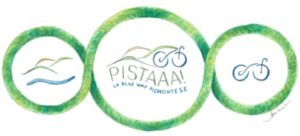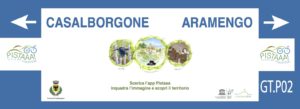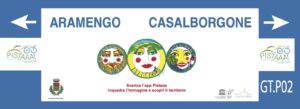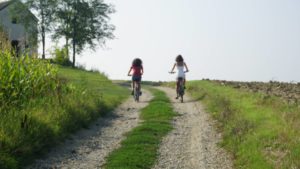Cycling, sustainability and love for the territory: these are some of the key words that define the richness of the project “Pistaaa: the Piedmontese Blue Way“, conceived and curated by the cultural association of social promotion CioCheVale, which encourages the creation and optimisation of bicycle and pedestrian routes on paths and dirt roads (i.e. routes that already exist), in order to avoid cementing, which is highly impactful on the environment. Cyclo-pedestrian routes foster the knowledge of the area beyond Turin’s hill through sustainable tourism, generating hospitality opportunities by local tourist accommodation and promoting local products.
The signage of the Piedmontese Blue Way routes is inextricably linked to the Third Paradise, as it includes artistic works framed in Michelangelo Pistoletto‘s trinamic symbol. Alberto Guggino, president of CioCheVale and Rebirth/Third Paradise ambassador, emphasises how much the Third Paradise and its value of seeking balance between nature and artifice are connected to the association’s purpose; Pistoletto’s sign-symbol was in fact used in the actual project’s logo. “The first paradise, the nature of the territory in which we are, is represented by the hills beyond the Piedmontese capital and the waters of the River Po, whose original course passed through those same hilly territories,” Guggino explains. In the circle on the right, depicting the artifice, is a bicycle, the symbol of the initiative; the balance between the two circles generates the Piedmontese Blue Way.

The logo of the project “Pistaaa: the Piedmontese Blue Way”.
With “Pistaaa: the Piedmontese Blue Way,” art enters into synergy with the territory and actively includes its inhabitants: “To mark the routes, instead of using a QR code,” Guggino points out, “we have preferred to make signs designed by local artists”. Casalborgone’s Third Paradise is a collaboration of three artists: M. Nazzarena Braidotti, Lorenzo Dotti and Domenico Siccardi. “It seemed to me that the Leu, the historic centre of the village,” says M. Nazzarena Braidotti in reference to the central circle she created, “shows us what the salvific balance between natural beauty and human activity can be”. Below the Leu, an ancient settlement of Casalborgone whose name means “place,” is depicted the hat with the tricolour cockade symbol of the Abbadia, “an institution founded in the 1600s that gives life to the ritual celebrations of Casalborgone’s Ferragosto at the Leu,” the artist explains.
The circle on the left depicts the Bosc Grand Nature Reserve, in the heart of the Po Hill Biosphere Reserve, which is “a precious treasure chest of biodiversity: it homes luxurious greenery including ancient specimens of turkey oak, oak, chestnut and majestic beech trees,” says author Lorenzo Dotti. Flying through the foliage of the nature reserve is the black woodpecker, the largest specimen of this type of bird in Europe.
Domenico Siccardi illustrated the right circle of the trinamic symbol, where you can glimpse “a smiling angel watching over the night”. The artist describes the old-fashioned mill depicted in the frame, an imposing building whose illuminated windows shine in the night: “Biove, filoncini, michette, rosette, baguette, donuts, cakes… pizzas! Here is the result, also thanks to that smiling guardian angel,” the author concludes. A further tribute in the work is dedicated to peas, the protagonists of the Casalborgone Pea Festival: “All around is a circle of green peas, which from the nature of the first paradise, where they were one of the typical riches of the area, move to the trade routes of the second paradise, to return to the centre of the Third Paradise,” M. Nazzarena Braidotti explains.

Sign of the Piedmontese Blue Way illustrated by M. Nazzarena Braidotti, Lorenzo Dotti and Domenico Siccardi.
Illustrating Aramengo’s Third Paradise was artist Giorgio Franco, with a work that places the sun in the first paradise “to represent light, warmth and energy,” says the artist, whereas the opposite circle features the moon, which with its phases “allows the land to be cultivated in such a way to obtain the typical products of the area”. In the centre is the face of Mother Nature, serene and reassuring, whose eyes look at “a symbolic passage of man on a bicycle,” Franco explains. The artist concludes his description of the work with a reflection on cycling, at the heart of the Pistaaa! project and a human practice that respects nature: “The bicycle is a means that reflects the passage of man, respecting natural balances”.

Sign of the Piedmontese Blue Way illustrated by Giorgio Franco.
After downloading the Pistaaa! App by framing the drawing on the sign, you are redirected to a list of different organizations in the area embarking on a path of sustainability in line with the association’s manifesto, which, in turn, is inspired by the goals of the UN’s 2030 Agenda for Sustainable Development: “Through a controlled self-assessment, ranging from one to three stars, the organizations are stimulated to continually improve in terms of sustainability. This is not a judgment,” Guggino stresses, “but a push for change in favour of the environment and the territory”. This develops a synergy between local residents and businesses working to create an ethical network focused on the enhancement of local products and the territory’s natural and artistic heritage.


